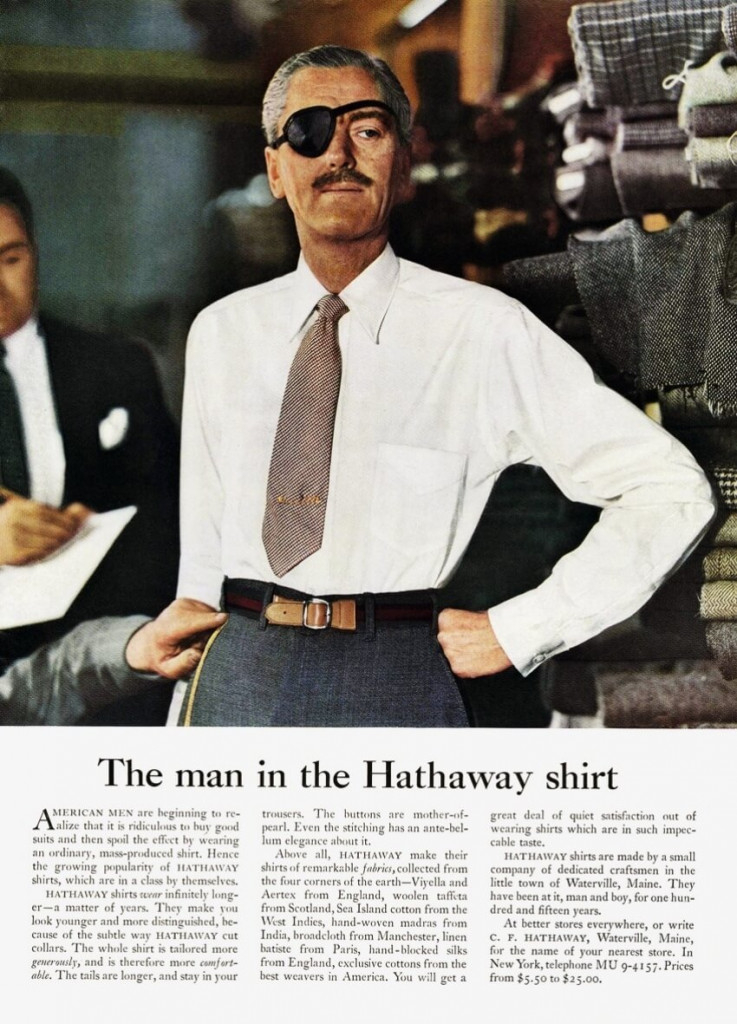The less money you have, the more curious energy your ad needs.
A tiny men’s shirt company in Waterville, Maine was hidden by the shadow of giants. By the time they hired Dave to help with advertising, post-war ready-made factory shirts were dominating the racks of department stores. In short, the company was (literally) losing its shirt.
Dave, a talented copywriter, had already written elegant words to match the quality of the shirts. A distinguished model was hired for the print ad, and a top New York photographer was ready to take pictures. Before arriving at the photography studio, Dave stopped at a drugstore to pick up some eyepatches.
Handing them to the photographer, he said, “Just shoot a couple of these to humor me. Then, I’ll go away, and you can do the serious job.”

David Ogilvy’s “The Man in the Hathaway Shirt” ushered in a new era of storytelling in advertising. The story, however, took place entirely in your imagination. Before you stood a distinguished gentleman being measured by a tailor. Who is this guy? What happened to his right eye? Is he an aristocrat? A war veteran?
Whatever trauma befell the man in his past, he stands unflinching and proud. He’s successful. Determined. Debonair. You must lean into this ad and try to figure out the story. You have no choice. Your brain won’t let you pass it by. You want to be this one-eyed-guy.
The first ad placed in The New Yorker cost $3,100. Before the week was over, you couldn’t find a Hathaway shirt anywhere in the five boroughs.
The formula? The less money you have, the more curious energy your ad needs. The more competition you have eating up mindshare, the more quirk you must employ.
This doesn’t mean being outrageous or insane (I’m looking at you, car dealers), it means you better add a little more paprika. Make me tilt my head just slightly and say “huh… what’s up with that?” Break the pattern with something that doesn’t belong; but fits.
Sometimes, it’s as simple as a 50 cent eyepatch.
Bonus: The Copy
American men are beginning to realize that it is ridiculous to buy good suits and then spoil the effect by wearing an ordinary, mass-produced shirt. Hence the growing popularity of HATHAWAY shirts, which are in a class by themselves.
HATHAWAY shirts wear infinitely longer – a matter of years. They make you look younger and more distinguished, because of the subtle way HATHAWAY cut collars. The whole shirt is tailored more generously, and is therefore more comfortable. The tails are longer, and stay in your trousers. The buttons are mother-of-pearl. Even the stitching has an ante-belum elegance about it.
Above all, HATHAWAY make their shirts of remarkable fabrics, collected from the four corners of the earth – Viyella and Aertex from England, wollen taffeta from Scotland, Sea Island cotton from the West Indies, hand-woven madras from India, broadcloth from Manchester, linen batiste from Paris, hand-blocked silks from England, exclusive cottons from the best weavers in America. You will get a great deal of quiet satisfaction out of wearing shirts which are in such impeccable taste.
HATHAWAY shirts are made by a small company of dedicated craftsmen in the little town of Waterville, Maine. They have been at it, man and boy, for one hundred fifteen years.
At better stores everywhere, or write C. F. HATHAWAY, Waterville, Maine, for the name of your nearest store. In New York, telephone MU 9-4157. Prices from $5.50 to $25.00
- Marketing Has a Physics Problem - December 3, 2025
- AI is OK - August 14, 2025
- Emotion in Advertising Equals Dollars in Business - December 3, 2024
